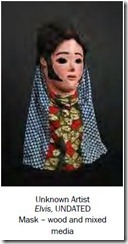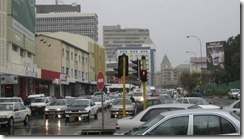Some friends and I crossed the land border between the Democratic Republic of the Congo (DRC) and Zambia last weekend for a short trip to Lubumbashi in Katanga Province. Katanga includes the panhandle of the DRC that juts into Zambia and nearly divides it into two pieces. The land border crossing between the DRC and Zambia was so crazy that I thought it merited its own blog entry. If you ever visit Zambia on a longer trip and have some time to take a short jaunt up to the DRC to see the southern (and safest) part of the country, you might consider driving across the border. It’s quite an adventure and (I think) worth the trip.
When you approach the Zambian-DRC border from the Zambian Copperbelt region, don’t drive directly to the border or else you will be stuck in the middle of a long line of trucks and find it difficult to turn your vehicle around.
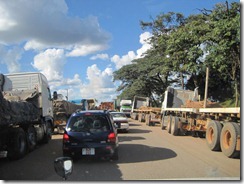
Look for a tarred (paved) road turning right from the main highway about 200 meters before the border. There you will find the turn-off to the Zambian Immigration and Customs facility. The Zambian side features a brand-new, beautiful structure that houses both the inbound and outbound Immigration and Customs offices. It’s stunningly nice and orderly. Looks can be deceiving however, because the process of exiting and entering Zambia is more confusing than it seems. Following these steps will help make your passage through the border easier and quicker:
- Park on the far side of the building.
- Go in and do your exit paperwork at Zambian Immigration. Be sure to have a valid passport, visas for both Zambia and the DRC, and your World Health Organization (WHO) Immunization card (affectionately known as the “yellow shot card.”) If you’re a permanent resident of Zambia, your Zambian ID will also be helpful.
- Go outside and drive your car to the exit scales where a customs officer will weigh your car and give you paperwork to take to Zambian Customs for processing.
- Go back into the facility and process your customs paperwork. Don’t forget to bring your valid driver’s license (Southern African Development Community [SADC] or international driver’s license preferred), vehicle title and registration, and proof of local insurance. If it’s a car rental, be sure your rental company will allow you to take the car to the DRC and provided you with the necessary supplemental paperwork. You may have to pay a customs fee (diplomats are exempt). Be sure to get the gate pass (a small piece of paper like a ticket) and Customs Importation Permit (CIP) showing you’re authorized to take the car in and out of Zambia.
- After processing your customs paperwork, go back to your car and drive out through the gate near the building. It’s tricky to locate with all the trucks blocking the way. Zambian officials will open the gate for you to pass through after you give them the gate pass and CIP.
Now the fun begins. Bypass the tarmac (paved road) in the “no man’s land” between Zambia and the DRC and take the rough dirt road to the left of the tarmac. It’s easier to navigate the standing water and potholes with a larger vehicle. The reason for the bypass is that trucks are parked on the tarmac waiting to enter the DRC in the evening and will likely block your way. A number of aggressive English-speaking Congolese will seek you out to “help” you get through the border; they may be helpful but be sure to set expectations first. They are more helpful on the chaotic DRC side of the border, especially if no one in your group speaks French or Swahili, the two main languages spoken in Katanga Province.
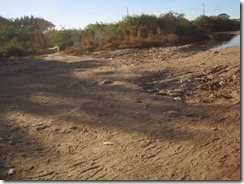
DRC Immigration and Customs sits about 150 meters north of the Zambian facility and is to the right of the tarmac mentioned above. Cut through the trucks until you see a locked gate (yes, locked – not too many passenger vehicles apparently are intrepid enough to enter the DRC to warrant keeping it open). Your adopted Congolese border “guide” will help flag down a DRC official to open the gate for you; you can find one yourself if you have the French and the nerve to try it. Drive through the gate on the north side and park in the dirt alley next to the all-in-one gaudy blue and yellow Immigration and Customs facility that looks as if it was built in the 1960s and went through a civil war (sans the bullet holes).
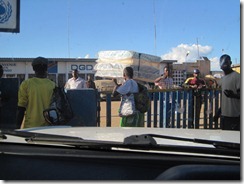
The guide will take you to the small office where you may be haggled or harassed by DRC border officials who sit behind faux glass while hawkers and money changers accost you with whatever they’re selling in their hands. Officials and bystanders masquerading as assistants will be looking for any excuse to solicit extra “fees” and levy “fines,” so have your paperwork lined up. Passport with Congolese visa, check. Yellow shot card, check. Vehicle paperwork, check. SADC insurance valid in the DRC with receipt, check. It’s apparently normal procedure to be harassed and pressured to pay some money to make the problem go away, so don’t worry about being treated with suspicion at the DRC border and go with the flow. It’s part of the charm of the DR Congo. Eventually the issues will be cleared up, problems solved, and you’ll be on your way. If possible, have one traveler watch over the vehicles while you’re processing your paperwork. Lock your valuables in the car and keep your personal items close.
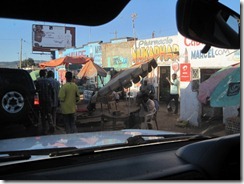
Whatever you do, DO NOT take any photographs at the border unless you are willing to have your camera taken away from you. If you do try to snap some shots, be very, very, very discreet. The Congolese are hyper-sensitive about photos at the border.
Once you’ve gone through the border once, it’s easier to go back through and should take you less time. Just do the steps above in reverse order. The entire process took us 1.5 hours to enter the DRC and one hour to re-enter Zambia, which may be a record. I’d heard horror stories of visitors stuck at the border for over four hours! We got lucky.
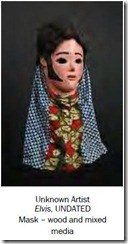 One day not long ago, I first encountered what I thought was a bust of Elvis Presley. His image was unsettling, as if his face had been surgically removed a la the movie “Face/Off.” I soon realized that it was a handmade ceremonial mask of “The King” made in the Chewa tradition. I thought it odd that the Chewa people of central and southern Africa would fashion a mask honoring a 1950s American music icon. What I initially found creepy – to be honest – has now become an intriguing fixture in my life. “Elvis” now pops up in mysterious places at odd times as if possessed by a ghost or repositioned by a trickster. One never knows when Elvis will be sitting in front of a podium ready to deliver a speech or at the water fountain waiting for a drink.
One day not long ago, I first encountered what I thought was a bust of Elvis Presley. His image was unsettling, as if his face had been surgically removed a la the movie “Face/Off.” I soon realized that it was a handmade ceremonial mask of “The King” made in the Chewa tradition. I thought it odd that the Chewa people of central and southern Africa would fashion a mask honoring a 1950s American music icon. What I initially found creepy – to be honest – has now become an intriguing fixture in my life. “Elvis” now pops up in mysterious places at odd times as if possessed by a ghost or repositioned by a trickster. One never knows when Elvis will be sitting in front of a podium ready to deliver a speech or at the water fountain waiting for a drink.











